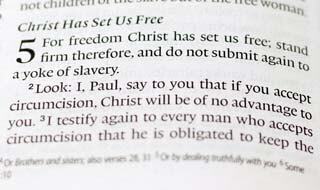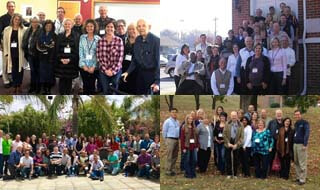
“But we see Jesus, who was made a little lower than the angels, for the suffering of death crowned with glory and honor, that He, by the grace of God, might taste death for everyone” (Heb. 2:9).
A young Christian who had been meditating much upon the Redemptive work of Christ, found difficulty in perceiving how she, as a sinner, received what she deserved in Christ’s dying for her. She believed the facts as stated in the written Word of God, but her sense of justice said, “I ought to be punished for my sin. It does not seem fair for another to be punished for what I have done.”
God very preciously gave her the illumination that she needed one night in a dream, in which she saw one whom she loved standing as a culprit before a stern, frowning figure representing Justice. The face of the wrongdoer wore a guilty, apprehensive look, as if the descending rod in the hand of Justice was about to administer a deserved yet fearful punishment. Just as the heavy rod was about to fall upon the extended hand of the culprit, the young woman herself, personifying love, rushed forward, and placing her upturned hand in the hand of the guilty one, caught the full force of the blow. The culprit’s face revealed the consciousness of having received deserved punishment and at the same time it manifested true sorrow for the wrongdoing; a sorrow that was awakened by love’s suffering interposition and substitutionary act. The young woman was then able to see that she had been punished; that personally, she received what she deserved as a sinner; but Christ had felt the force of the blow.
Here we see both identification and substitution. When we say, “Christ died for me,” we refer to an element of His death that we could not share-(the force of the “stroke”): this is the Substitutionary Aspect of His death. When we say, “In Christ I died,” we refer to the fact of our identification with Him in His death as our Representative [Col. 3:3,9].
The Death That Christ “Tasted”
But now let us more seriously examine the substitutionary aspect of His death. What is meant by His “tasting death for every man?” (See Heb. 2:9.) Clearly this refers to something more than dissolution. What was this death? Let us again recall the definition of death as stated in our earlier lessons: “Death is a falling out of correspondence with environment.” It is the logical result of sin. Sinners cannot respond to God. This inability to respond causes a realized separation from Him. We have found that, so far as man is concerned, this separation would be of everlasting duration. Everlasting separation from God would mean everlasting death. This was the death that Christ “tasted.”
We see then very plainly that had He been the son of Joseph, and by a miracle the law of heredity had been set aside in order to render the child of sinful parents a sinless being, Only a Being who possessed Uncreated Life could “taste” everlasting death without being held in its power. His benevolent attempt to become a sacrifice for the sin of His race would have involved Himself in this everlasting death; and it would not have effected any change in the status of the members of the race.
Only a Being who possessed Uncreated Life could “taste” everlasting death without being held in its power. Only a Being who was under the “law of the Spirit of Life” [Rom. 8:2] could come within the sphere of the operation of “the law of sin and death” and render it inoperative by rising above it.
A very simple illustration will enable us to grasp the meaning. An eagle is perched upon a crag overlooking a precipice. A serpent glides noiselessly towards the rock and fastens its coils upon the body of the bird. Both fall over the edge of the precipice, but before the bottom is reached, the eagle disentangles itself from the coils of the serpent and flies far up in the air, while the serpent falls to the earth below. The serpent is controlled by the force of gravity which draws it to the ground. The eagle feels the force of gravitation but overcomes it by the force of levitation.
The God-Man came into the world “with a death-bearing body and a Life-giving power” (Dr. Mabie); therefore, He could go down to the sphere of everlasting death, and rising above it in His Uncreated Life, He could take with Him those who should choose to go [Rom. 6:4,5].
We are now able to perceive that something more than the death of Christ is needed to meet all the requirements of God’s Plan of Redemption. The claims of God’s holiness have been satisfied, but the claims of God’s Love must also be met. God wants sons [and daughters]–beings who shall share His Life; therefore the Last Adam [Jesus Christ] must be manifested as the Head of a new order or race of righteous, holy, glorified human beings. This transformation of sinful human beings would seem to be analogous to the reconstructive work of God as narrated in Genesis 1:2, and might be fittingly termed a “new creation.” (See 2 Cor. 5:17.) [1]
.
Part 1 of 2
An excerpt from Mary E. McDonough’s study, God’s Plan of Redemption (1922).
[1] Ms. McDonough alludes to the interpretation of Genesis 1:1-3 that the earth became “without form and void” through a catastrophe such as the fall of Satan. Thus the creation days (Gen. 1:3-31) were a recreating of earth for life on the planet. This view has become known as the Gap Theory. Even if this interpretation of Genesis 1:2 is not accepted, the author’s comparison can be appreciated.
Bracketed references added. Some phrases were edited from addressing a class teacher to addressing the reader directly.
Honorable Mention
Frank Viola’s blog, books and classes contain helpful messages on the Deeper Life in Christ, such as https://frankviola.org/missing-ingredient/

















